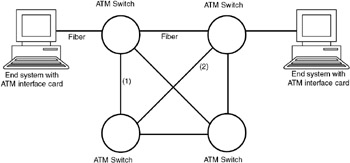Chapter 29: Asynchronous Transfer Mode
|
| < Day Day Up > |
|
The concept of packet switching is fundamental to data communication. An important design issue in packet switching networks is the size of the packet. If the packet is very large, large buffers are required at the packet switches, the switching is very slow, and delay is high. On the other hand, if the packet is very small, switching is fast but the overheads are high because each packet has to carry control information. Variable packet size generally is used in packet switching networks, but variable size leads to computation overhead and variable buffer size. Asynchronous Transfer Mode (ATM) is an attractive packet switching technology that achieves fast packet switching with small packets of fixed size. ATM technology is an outcome of the developments in broadband ISDN. ATM now holds great promise for multimedia communication, and this technology is now being deployed extensively in both LANs and WANs. In this chapter, we will study the concepts and protocol architecture of ATM.
29.1 CONCEPTS OF ATM
In ATM networks, a special node called an ATM switch is used to which computers are connected. Because of the high speeds supported by ATM, a pair of multimode optical fibers is used to interconnect the computers with the ATM switch. An ATM interface card is plugged into the computer; it contains an LED or laser that converts the data into light signals that are sent over the fiber. The ATM interface card also contains a sensor that converts the light signals back to data to be given to the computer. An ATM network is formed by interconnecting two or more ATM switches as shown in Figure 29.1.

Figure 29.1: An ATM network.
An ATM network consists of a number of ATM switches. The end systems are connected to the ATM switch through an interface card, which contains the interfaces for optical fiber.
In ATM, each packet is called a cell. The cell size is 53 bytes—a 5-byte header and 48 bytes of data. The small and fixed size of the cell ensures faster processing of the cells and hence faster switching and simple hardware implementation.
In ATM, each packet is called a cell. The cell size is 53 bytes—5 bytes of header and 48 bytes of data. The small cell size facilitates fast switching of the cells.
In an ATM network, for two computers to exchange data, a connection has to be established, data transferred, and connection released. Hence, ATM provides a connection-oriented service.
There are two types of connections in ATM:
-
Switched virtual circuit
-
Permanent virtual circuit
When a host wants to communicate with another host, the sender makes a request to its switch, and the switch in turn establishes a connection with the other host. A 24-bit identifier known as virtual circuit identifier is used to identify the connection. Then all the packets are transmitted over this connection. This is known as switched virtual circuit. At the time of connection, each ATM switch allocates the necessary resources, such as buffers, incoming port, and outgoing port, for routing the cells.
Virtual circuits that are dedicated connections between two end systems are called permanent virtual circuits.
| Note | In an ATM network, two types of connections can be formed: Switched Virtual Circuit (SVC) and permanent virtual circuit (PVC). SVC is formed on a per-call basis, whereas PVC is a permanent connection. |
The 24-bit identifier for a virtual circuit is divided into two portions—virtual path identifier (VPI) of 8 bits and virtual circuit identifier (VCI) of 16 bits.
The virtual circuit is identified by a 24-bit field, out of which 8 bits are to identify the virtual path and 16 bits are to identify the virtual circuit.
The most attractive feature of an ATM network is that it provides the required quality of service (QoS), unlike the TCP/IP networks that do not guarantee the QoS. For instance, if video conferencing has to be established between two end systems, a certain bandwidth is required for the video and audio transmission. The delay also should be minimum. Such QoS parameters can be set at the time of establishing the virtual circuit.
|
| < Day Day Up > |
|
EAN: 2147483647
Pages: 313